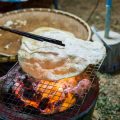Introduction to Make-Ahead Backpacking Meals
Backpacking through America’s breathtaking landscapes is an adventure of a lifetime, but planning your meals can make or break your experience. That’s where make-ahead backpacking meals come in—a game-changer for outdoor enthusiasts looking for convenience, nutrition, and unforgettable flavors on the trail. Preparing your meals in advance means you can leave the stress of meal prep behind and focus on soaking up every moment of your journey. Imagine ending a long day of hiking with a hearty, delicious dinner that’s ready in minutes! With pre-prepared options, you not only save time and energy but also ensure your food packs the nutrients needed to keep you energized and healthy. Plus, having homemade meals lets you control what goes into your pack—no more mystery ingredients or bland freeze-dried fare. Check out the table below for a quick overview of why make-ahead meals are a smart choice for backpackers who crave both efficiency and big flavor.
| Benefit | Description |
|---|---|
| Convenience | No need to cook from scratch at camp; just heat and eat! |
| Nutrition | Customize meals for dietary needs and balanced energy. |
| Flavor | Enjoy home-cooked taste and variety far from civilization. |
| Weight Savings | Pack lighter by dehydrating or portioning meals efficiently. |
| Less Waste | Avoid excess packaging and reduce trash on the trail. |
Whether you’re trekking through the Rockies or camping out in Yosemite, make-ahead meals offer backpackers the freedom to explore further while enjoying top-notch eats along the way. In this guide, we’ll show you how easy it is to prepare lightweight meals that don’t skimp on flavor, so you can fuel your adventures with something truly satisfying.
Key Principles for Backpacker Meal Prep
When it comes to prepping meals for backpacking trips, a few key principles can make all the difference in ensuring your food is both satisfying and trail-ready. The main goals are minimizing weight, maximizing nutrition and flavor, and maintaining food safety. Here’s how to tackle each of these crucial elements:
Weight Considerations
Every ounce counts when you’re carrying your kitchen on your back. Opt for lightweight ingredients and focus on dehydrated or freeze-dried options whenever possible. Avoid canned goods and anything with excess packaging. To help you plan, here’s a quick comparison:
| Ingredient Type | Typical Weight (per serving) | Backpacker Friendly? |
|---|---|---|
| Canned Beans | 8 oz | No |
| Dehydrated Beans | 1 oz | Yes |
| Pasta (dry) | 2 oz | Yes |
| Fresh Vegetables | 6 oz | No |
| Dried Vegetables | 0.5 oz | Yes |
Smart Ingredient Choices
Select ingredients that are calorie-dense, nutrient-rich, and versatile. Think instant rice, dried beans, powdered eggs, nut butters, and shelf-stable cheese. These not only save space and weight but also provide the energy needed for long days on the trail. Spices and seasoning packets are lightweight heroes that bring big flavor without bulk.
Top Lightweight Staples for Flavorful Meals:
- Dehydrated grains (rice, quinoa, couscous)
- Dried protein sources (jerky, tuna packets, lentils)
- Shelf-stable fats (olive oil packets, ghee sachets)
- Dried fruits and nuts for snacks or meal add-ins
- Instant soup mixes and bouillon cubes for broths or sauces
Food Safety Tips in the Backcountry
Proper food handling is essential to avoid illness miles away from help. Always pack foods in airtight containers or resealable bags. Keep raw foods separate from ready-to-eat items. When using make-ahead meals, consider the following guidelines:
- Avoid perishable dairy or meats unless they’re freeze-dried or shelf-stable.
- If prepping at home, dehydrate cooked meals fully to prevent spoilage.
- Date-label all prepped meals to use oldest first.
- Practice Leave No Trace by packing out all food scraps and packaging.
Quick Tip:
If you’re new to dehydrating meals at home, start with simple recipes like chili or pasta sauce and always test them before your trip to ensure they rehydrate well in camp conditions.

3. Lightweight, Nutrient-Dense Ingredients
When planning make-ahead meals for backpacking, choosing ingredients that are both lightweight and packed with nutrients is key. These foods save pack space and weight while keeping your energy high on the trail. Here are some popular options you’ll easily find in most American grocery stores:
Popular Lightweight Ingredients for Backpackers
| Ingredient | Nutrition Highlights | Flavor & Uses |
|---|---|---|
| Dehydrated Vegetables | Rich in vitamins, minerals, and fiber; very low weight after drying | Add to soups, stews, or instant noodle dishes for extra nutrition and flavor |
| Instant Rice & Quinoa | High in carbs for energy; quinoa offers protein and amino acids | Serve as a base for curries, chili, or stir-fry mixes |
| Pouched Tuna or Chicken | Lean protein source; no refrigeration needed; comes pre-cooked | Add to wraps, pasta salads, or rice dishes for a protein boost |
| Dried Beans & Lentils (Pre-cooked or Instant) | Packed with protein and fiber; light and compact when dried | Mash into spreads, mix into grain bowls, or use in soups and stews |
| Nuts & Seeds (Almonds, Pumpkin Seeds) | Healthy fats, protein, and calories; long shelf life | Eaten alone as a snack or added to oatmeal and trail mixes |
| Powdered Nut Butters (Peanut/Almond) | Concentrated calories and healthy fats; just add water to rehydrate | Spread on tortillas, add to sauces, or mix into breakfast grains for richness |
| Dried Fruit (Apricots, Cranberries) | Naturally sweet source of quick carbs, fiber, and antioxidants | Add to oatmeal, trail mix, or eat as a dessert treat on the trail |
| Instant Oatmeal Packets | Complex carbs for sustained energy; often fortified with vitamins and minerals | A quick hot breakfast—customize with nuts, seeds, dried fruit, or powdered milk |
| Couscous & Pasta Sides (Instant Varieties) | Lightweight staples; cook quickly using minimal fuel and water | Combine with seasonings, dehydrated veggies, or pouched proteins for a full meal |
| Coconut Milk Powder & Cheese Powders (Shelf-Stable) | Adds creamy texture and flavor along with calories from healthy fats/protein | Makes sauces richer—great in curries, pasta dishes, or mashed potatoes on the trail |
Why These Ingredients Work for Backpackers?
- Nutrient Density: Each ingredient packs a lot of nutrition per ounce—key when every pound counts.
- Shelf Stable: No refrigeration needed so you can carry them safely over several days.
- Versatility: Many of these foods combine well together for creative meal options without adding bulk.
- Big Flavor: Dehydrated spices (like taco seasoning or Italian herbs), cheese powders, and even instant soup bases help keep meals exciting without adding much weight.
Shopping Tips at American Grocery Stores:
- Look for “instant” or “quick-cooking” labels in the rice/pasta aisle.
- The natural foods section often has bulk bins of nuts, seeds, dried fruit, and dehydrated veggies.
- Pouched meats are usually near canned tuna/chicken but weigh less due to no liquid.
- Baking aisles have powdered nut butters and sometimes coconut milk powder.
Packing Pro Tip:
Repackage bulk items into zip-top bags at home to save space. Mix your own combos—like instant oats plus chia seeds and dried blueberries—for grab-and-go meals with maximum flavor and nutrition on your next adventure!
Flavor Boosters and Seasoning Hacks
Just because you’re miles from the nearest kitchen doesn’t mean your meals have to be bland! When preparing make-ahead meals for backpacking, packing smart, lightweight flavor boosters can transform simple dishes into memorable campfire feasts. Here are some tips and tricks to ensure every bite is packed with taste, using ingredients that resonate with American palates.
High-Impact Spices: Compact but Mighty
Spices take up almost no space in your pack but deliver a huge payoff. Consider making a custom spice kit tailored to your favorite flavors. A small pill organizer or a few resealable mini-bags work perfectly. Here’s a quick reference guide:
| Spice/Blend | Flavor Profile | Best For |
|---|---|---|
| Taco seasoning | Smoky, savory, slightly spicy | Rice bowls, wraps, scrambled eggs |
| Cajun blend | Zesty, peppery, bold | Pasta, beans, dehydrated chicken |
| Everything bagel seasoning | Garlicky, crunchy, salty | Oatmeal, instant mashed potatoes, tuna packs |
| Cinnamon-sugar mix | Sweet and warm | Breakfast grains, coffee, trail snacks |
| Dried parsley & chives | Herbaceous and fresh | Noodle soups, potato dishes, omelets |
Sauces & Condiments: Flavor in Small Packages
Single-serve condiment packets are a backpacker’s best friend. Grab extras of your favorites from restaurants or purchase travel-size bottles. They add little weight but tons of flavor. Some top picks for Americans include:
- Sriracha or hot sauce packets for a spicy kick on anything from ramen to eggs.
- Soy sauce or tamari for Asian-inspired dishes.
- Peanut butter or almond butter squeeze packs for protein and richness in oatmeal or wraps.
- Honey sticks—perfect for sweetening tea or drizzling over granola.
- Mayo and mustard packets for sandwiches and wraps.
- Taco Bell Fire Sauce or BBQ sauce packets for bold smoky flavor.
Packing Tips for Maximum Freshness & Minimal Mess
- Double-bag powders: Prevent spills by placing spice bags inside a second zip-top bag.
- Label everything: A permanent marker helps you grab the right flavor in low light.
- Avoid glass containers: Stick to plastic or flexible packaging for weight savings and safety.
- Portion control: Only bring what you’ll need—spices and sauces go a long way!
Your Camp Kitchen Game-Changer
The right combination of spices and sauces makes all the difference between just “eating” and truly enjoying your backpacking meals. With these flavor boosters in your pack, you’ll savor every bite—even out in the wild!
5. Favorite American-Style Make-Ahead Recipes
Nothing brings comfort on the trail quite like familiar flavors from home. Backpackers who crave classic American tastes will love these easy-to-prepare, lightweight meals that deliver both nostalgia and nourishment. Here’s a selection of make-ahead recipes inspired by all-American favorites, adapted for the great outdoors.
Classic Trail Chili
Chili is an iconic American meal that packs protein and warmth. Prepare a dehydrated version at home by cooking lean ground beef (or turkey), black beans, kidney beans, tomatoes, corn, and chili spices. Dehydrate the mixture until crisp. On the trail, just add hot water and let it rehydrate for 10 minutes for a hearty dinner.
Buffalo Chicken Wraps
This spicy favorite is easy to adapt for backpacking. Mix cooked shredded chicken breast with buffalo sauce and dehydrate until dry. Pack in airtight bags along with whole wheat tortillas and single-serve ranch packets. At camp, rehydrate chicken with a bit of water, then wrap in tortillas for a zesty lunch or dinner.
Mac ‘n’ Cheese Power Bowls
A beloved American comfort food, mac ‘n’ cheese can be made trail-ready by using elbow macaroni and powdered cheese sauce mix. Boost nutrition by adding dehydrated peas or broccoli. Pre-mix your ingredients at home for fast assembly on the trail—just boil water, stir in the mix, and enjoy.
Easy Make-Ahead Recipe Table
| Recipe Name | Main Ingredients | Prep Steps at Home | Trail Assembly Tips |
|---|---|---|---|
| Classic Trail Chili | Ground beef/turkey, beans, tomatoes, corn, spices | Cook & dehydrate full mixture | Add boiling water; soak 10 min |
| Buffalo Chicken Wraps | Chicken breast, buffalo sauce, tortillas | Mix & dehydrate chicken; pack wraps separately | Rehydrate chicken; assemble wraps with ranch packet |
| Mac ‘n’ Cheese Power Bowls | Pasta, cheese powder, dehydrated veggies | Pre-mix dry ingredients in baggies | Add boiling water; stir well until creamy |
| Cranberry Almond Oatmeal | Oats, dried cranberries, almonds, brown sugar | Combine all dry ingredients in portioned bags | Add hot water in morning; ready in 5 min |
| BBQ Pulled Pork Couscous | Pulled pork (dehydrated), BBQ sauce powder, couscous | Dehydrate pork; pack couscous & seasoning separately | Add boiling water to couscous & pork; mix together after 8 min |
S’mores Energy Bites
No American campout is complete without s’mores! For a portable twist, combine graham cracker crumbs, mini marshmallows, chocolate chips, honey, and peanut butter into no-bake energy balls. Store them in an airtight container—they’ll satisfy your sweet tooth after a long hike.
With these make-ahead American-style recipes, you can enjoy big flavor without carrying extra weight or spending hours cooking at camp. They’re perfect for keeping spirits high and bellies full while exploring the backcountry.
6. Packing, Storage, and Rehydration Tips
Proper packing and storage are essential for keeping your make-ahead backpacking meals fresh, lightweight, and easy to prepare on the trail. Here are some tried-and-true strategies that seasoned American backpackers swear by:
Best Practices for Storing Prepped Meals
Choosing the right containers and storage methods can make or break your meal plan. Lightweight, resealable bags (like Ziploc Freezer Bags) are popular because they’re durable, minimize space, and can double as mixing or eating vessels. If you’re prepping dehydrated meals, vacuum-sealing them adds extra protection against moisture and air.
| Storage Method | Pros | Cons |
|---|---|---|
| Ziploc Bags | Lightweight, reusable, affordable | Not fully airtight; may puncture |
| Vacuum-Sealed Bags | Longest shelf life, compact | Requires special equipment |
| Plastic Containers | Sturdy, reusable | Heavier, bulkier |
| Silicone Pouches | BPA-free, eco-friendly, reusable | Expensive up front |
Keeping Food Fresh on the Trail
If your meals include any perishable ingredients (like cheeses or cured meats), keep them in a cool spot in your pack—close to your water reservoir or wrapped in clothing for insulation. Always store food away from your sleeping area to avoid attracting wildlife.
Pro-Tip: Portion Control Matters
Pre-portion your meals at home to save time and avoid waste. Label each bag with the meal name and cooking instructions using a permanent marker.
Easy Methods for Reheating or Rehydrating Meals
The key to hassle-free mealtime is minimizing cleanup and maximizing flavor. Here’s how most U.S. backpackers rehydrate their make-ahead meals:
| Method | Description | Best For | Tips & Tricks |
|---|---|---|---|
| Add Boiling Water Directly to Bag | Add hot water straight into the meal bag; seal and let sit. | Dehydrated/freeze-dried meals | Add an insulating cozy or wrap in a beanie for even rehydration. |
| Saucepan Cooking | Empty meal into pot; add water and simmer until ready. | Pasta/rice dishes with thicker sauces | Use a non-stick pot for easier cleanup. |
| No-Cook Soak | Add cold or room temp water ahead of time; let soak while hiking. | Muesli, overnight oats | Tightly seal bag to prevent leaks. |
Avoiding Common Pitfalls
Avoid over-packing heavy items like canned foods or glass jars—they add unnecessary weight. Stick with dried, lightweight ingredients when possible. And always practice Leave No Trace by packing out all food packaging and waste.
By following these best practices for packing, storing, and preparing make-ahead meals, you’ll fuel your adventures efficiently—without sacrificing big flavor on the trail!
7. Final Thoughts and Resources
Planning your meals ahead of time is one of the smartest moves you can make for a successful backpacking trip in the U.S. Not only do make-ahead meals save you time and energy on the trail, but they also ensure you’re enjoying flavorful, satisfying food after a long day of hiking. Remember to pack light, consider dietary needs, and always practice Leave No Trace principles when handling food waste.
Closing Advice
Start small—test recipes at home before hitting the trail. Focus on high-calorie, nutrient-dense options that are easy to rehydrate or heat. Invest in quality storage bags or lightweight containers to keep your food fresh and secure.
Further Reading
- REI Co-op: Backpacking Food Ideas & Meal Planning
- Backpacker Magazine: Trail Cooking Tips & Recipes
- Section Hiker: Backpacking Food Guides
Recommended Gear for U.S. Backpackers
| Gear Type | Popular Options | Why We Love It |
|---|---|---|
| Food Storage Bags | Opsak, Ziploc Freezer Bags | Odor-proof, lightweight, reusable |
| Ultralight Stove System | Jetboil Flash, MSR PocketRocket 2 | Fast boiling times, compact design |
| Bear Canister/Bear Bag | BearVault BV450, Ursack Major XL | Required in many U.S. parks; protects wildlife and food supply |
| Titanium Cookware | Toaks Titanium Pot, Snow Peak Trek 700 | Durable, ultralight, easy to clean |
| Water Filtration System | Sawyer Squeeze, Katadyn BeFree | Cleans water for meal prep; essential for safety on U.S. trails |
Community Resources for American Backpackers
- Reddit r/Ultralight – Community advice and real-world meal ideas from seasoned hikers.
- Backpacking Light Facebook Group – Connect with fellow backpackers for tips and trail-tested recipes.
- Leave No Trace Center for Outdoor Ethics – Guidance on responsible food storage and waste management.
- Hiking Project – Find trails, plan trips, and discover gear recommendations from local hikers.
Your Next Steps?
The world of make-ahead backpacking meals is as adventurous as the trails themselves. Try out new recipes, invest in quality gear, and tap into the vibrant U.S. backpacking community for ongoing inspiration. Happy trails—and happy eating!


